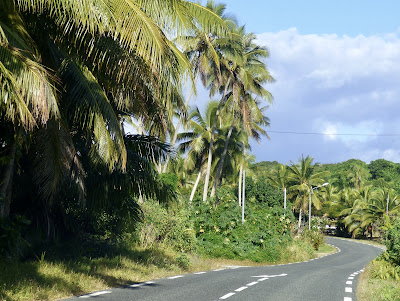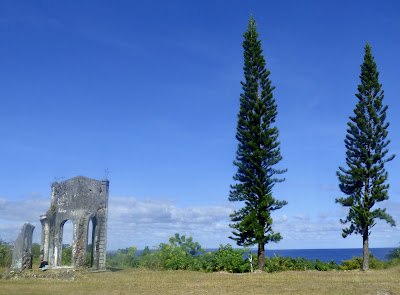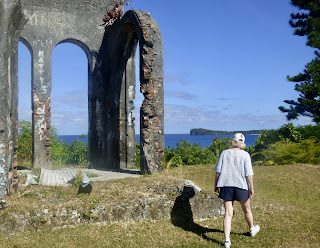Part 2: Island life
The following day we boarded the plane for the 40-minute flight to Lifou, due east from Grand Terre in the Loyalty Islands group. The island is the largest of the Loyalties, measuring around 81kms long and 24 kms wide. It is actually a raised coral atoll that was formerly part of a submerged volcano (we're talking 2 million years ago), flattish in the middle and surrounded by rugged rocky cliffs. Not much land has been cleared except for houses and the few towns, and most of the island remains thick jungle. The white sand beaches are simply beautiful.
Here you can see one of the island's main roads.
The population is around 9,000 made up mostly of various Kanak tribes that control their land and beaches; only about 2% of the population is of European descent. They grow taro, sweet potato, coconut, yams, bananas and vanilla but everything else has to be shipped in. Petrol stations often close if the boat bringing in petrol is delayed; the few stations on the island rotate their opening hours so there is always one station open. Too bad if the station near you is one that is closed. But that is island life and everyone seems to cope.
There are only three small resorts on the island. We stayed at Oasis de Kiamu. I use the word 'resort' loosely, for it was a low-key affair with a number of small bungalows dotted about the gardens, a swimming pool, a small restaurant and a gift shop offering the usual postcards, t-shirts, caps and thongs. But the people were friendly and helpful. And the food, served in the open air restaurant, was very good indeed (whole grilled lobster anyone?).
Other accommodation options are known as Tribal Homestays where you can stay in a hut on a property. We considered these but felt they were a bit too commercial and not a real reflection of the Kanak culture. You also had to share facilities which we're not keen on. This is a typical hut we saw on many properties.
A great advantage of our accommodation was that it had a private beach. We discovered that many of the beaches on Lifou were private and we only found a handful of public beaches where access was easy. In fact, on one occasion, after having spied a lovely stretch of sand and sea and were walking towards it, a tribesman approached us and said politely, 'Sorry. Private'. So it was a relief to be able to walk over the road and down to a beach we knew we were free to visit.
 |
| How lovely is this! |
Steve checked out the water temperature (mildly cool but not brutal, it is winter after all) and the next day went snorkelling.
He was quite proud of this photo he took with his small underwater camera.
I meanwhile preferred a stroll. No-one else around.
We had been well-advised to hire a car as the island is sparsely populated, there are only a few roads, and tours for independent travellers like us (that is, not cruise ship passengers) are hard to find or non-existent. So off we set with a map to explore the north of the island. I loved the roadside scenery and felt exhilarated, rather like Toad in Wind in the Willows, as we hit the open road. Steve meanwhile was contending with two aspects he hadn't encountered in a long time: driving on the right-hand side of the road and with a manual car.
Halfway up the island we passed through Wé, the commercial and administrative capital of Lifou. Not an attractive centre I have to say, it boasted an administrative building, the police station, a medical centre, a pharmacy and several businesses. We continued on.
However, two things were proving to be frustrating. 1) There were very few signs to indicate where we were and 2) every few metres there was a speed bump, so we had to slow down. Even where there was no settlement, there would be speed bumps; some were rubbery and easy to get over while some were high and concrete and rather treacherous if we came upon one unexpectedly at speed. Unfortunately, these speed bumps have remained in our memory as a distinguishing feature of the island. We were not alone though, as fellow travellers also commented, 'Those bloody speed bumps!'.
We were managing well with our navigation until we weren't. We drove around a roundabout and continued straight on as per the map and somehow ended up on the far western side of the island, not the far north. The map obviously bore no resemblance to reality. (Other people we spoke to later said they had also got lost at the exact roundabout.) Oh well, it was an adventure. We were in a town called Xepenehe so we stopped at a church and went inside where we chatted to the lovely people cleaning it.
They were keen to show us the history of the church, the stories of the missionaries who arrived early in the 19th century, and the French who annexed the island for themselves in 1864.
I loved the palm frond decorations.



We explored a ruined church behind the new church. I couldn't help but think of the people who had originally built it in this sublime setting by the sea. Why had it been abandoned?
 |
| A million-dollar view for these people. |
We drove a little further through the town...
... and came to a very pretty little cove.
Here, some children were playing, mothers keeping an eye on them, and a group of Kanaks busily setting up for a celebration. Feeling a little like intruders into what was obviously a community event, we immediately felt comfortable when people waved at us and called 'Bon jour'. Out came our cameras.
We wandered over to where the people were setting up their food.
Everyone seemed happy to see us.
It really was a lovely spot, so we were delighted that a wrong turn had led us here.
We visit a vanilla plantation
We continued north now, hoping we were heading for Mucaweng where the map indicated a vanilla plantation, vanilla being one of the main exports of Lifou. Suddenly, I spotted a sign.
And lounging at the entrance was Joseph.
This turned out to be the highlight of our day. Joseph was an amusing and informative guide who led us through the vanilla plantation, answered our queries, cut down coconuts for us to drink, showed us the drying vanilla beans, asked us innumerable questions about ourselves ('How old are you?'), and made us laugh. We were best mates by the time we left.

Here is a towering vanilla vine and a close up of a vanilla bean.
 |
Joseph cuts down some coconuts for us.

|
 |
Vanilla beans drying. 'They need sun, sun, rain, sun' Joseph tells us.
|
I bought a bottle of vanilla back at our accommodation's gift shop.
Interestingly, it is a combination of New Caledonian rum and vanilla.
My cakes should taste real yummy.
Bidding farewell to Joseph we headed further north to the Jokin cliffs, a recognised tourist viewing spot. We were not disappointed in the spectacular scenery of turquoise water, a sheltered bay, rocky cliffs, pine trees and the gentle sound of tumbling water.
We headed back 'home' now, taking time to photograph the lovely wildflowers along the roadside.






Back at the Oasis, I lounged by the pool, relaxed and warm and happy.
After lunch, we headed off to do the southern part of the island. All went well for a while, especially when we discovered a lovely public beach at the Baie de Wadra.
 |
| I could have stayed here for hours. |
We pulled ourselves away and continued travelling due west. The map showed the road going almost to the coast, but suddenly it swung right and we went with it. Wrong! We continued on, hopelessly lost again, until we realised we were driving north through the centre of the island. Here the jungle seemed to close in on us with the trees often forming a canopy overhead; it was actually quite beautiful.
We were determined to make the coast so at a crossroads we turned west again, and there it was. Checking our map, it appeared we had happened upon Cap Mandé and the nearby Plage de Peng which was described as '
a pretty beach appreciated for its calm and clear waters'. It certainly lived up to that description.


And of course I couldn't wait to feel that lovely, silky water.

Of course, locals always wanted to pose for us and here was no exception.
Reluctantly we turned the car around and headed back, not really knowing where we would end up.
Luckily a group of children and parents were congregating near a church hall so Steve approached with map in hand.

The children were delightful.
Aha - we now knew where we were and headed for 'home'. However - there was one more surprise - another beach. This was part of Baie de Chateaubriand a celebrated white-sand beach, hidden behind a church and a school that we had missed when we had passed this way in the morning.
This may have been our best beach yet. What do you think?
We celebrated our last night here with a delicious tuna with curry sauce followed by a dessert that appeared to be frozen coconut milk, fruit and I reckoned (though no-one else agreed) a touch of honeycomb. A delicious mystery.
I've popped in this map to remind us of where we went.
Tomorrow we head back to Noumea for the final leg of our trip.
To be continued.







 The children were delightful.
The children were delightful.
























































Well Lifou sounds the place to be and the resort seems heavenly to me - good food and beach. And I do like the motoring Toad image.
ReplyDeleteI'm glad you've replenished your vanilla stocks, and that icecream looks delicious. Plus fresh coconut. What will you be cooking next time I see you????? XXXX